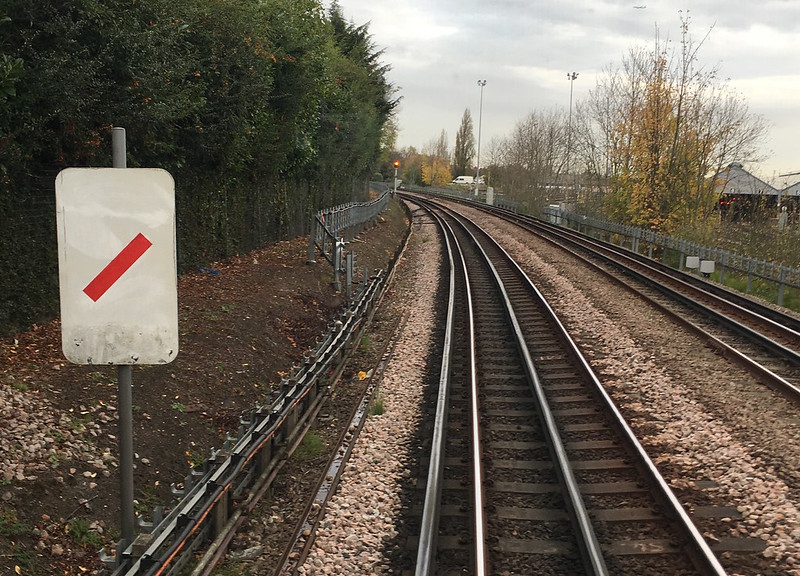|
|
Post by goldenarrow on Oct 29, 2017 9:45:06 GMT
The aforementioned signs have been on Network Rail infrastructure since about 2009. On NR these are usually mounted underneath sandite application markers. Q1) Were they (Low Adhesion Signs/Image 1)introduced on LU with the same design function intended? Q2) Are sandite application markers used on LU (Image 2)? Image 1: Example of Low Rail Adhesion Sign at Gunnersbury  Image 2: Examples of NR Sandite application signs from www.railsigns.uk |
|
rincew1nd
Administrator
Junior Under-wizzard of quiz
Posts: 10,286 
|
Post by rincew1nd on Oct 29, 2017 10:11:33 GMT
Are they used anywhere else other than Gunnersbury? Isn't that branch operated under Network Rail rules; the speed limit sign looks to be NR pattern.
|
|
|
|
Post by goldenarrow on Oct 29, 2017 10:44:47 GMT
Are they used anywhere else other than Gunnersbury? Isn't that branch operated under Network Rail rules; the speed limit sign looks to be NR pattern. Gunners to Richmond is indeed subject to NR rules. I asked because I've seen them used on the Uxbridge branch, there's a Low Rail Adhesion Sign just beyond signal A744 on the WB approach to Hillingdon and on signal A432 on the SB disused platform at Osterley Park & Spring Grove. Edit: Question on boards near Wimbledon Park has been answered further down, since they have nothing to do with low adhesion it has been removed from this post to limit continuity issues. |
|
|
|
Post by Dstock7080 on Oct 29, 2017 12:45:46 GMT
It's just occurred to me that the latter could be countdown markers but once again I thought those were NR signs because they pop up on the NB approach to Wimbledon Park too. Ones on approach to Wimbledon Park UP are a SPAD warning for signal W372 which sits on a tight left radius curve.  |
|
|
|
Post by goldenarrow on Oct 29, 2017 17:44:45 GMT
It's just occurred to me that the latter could be countdown markers but once again I thought those were NR signs because they pop up on the NB approach to Wimbledon Park too. Ones on approach to Wimbledon Park UP are a SPAD warning for signal W372 which sits on a tight left radius curve. (Believe these are white background with red stripes) , Thanks for clearing that up. It makes sense for signal MU 1 (WB before Ruislip IMR) because whilst it has a good headway and isn't on a tight bend, it does protect conflicting manoeuvres from the siding and associated crossovers. Image: 2nd of 3 boards before signal MU1 in the distance, the final board t is just behind the repeater.  |
|
rincew1nd
Administrator
Junior Under-wizzard of quiz
Posts: 10,286 
|
Post by rincew1nd on Oct 29, 2017 19:01:49 GMT
Sections 12.1 to 12.4 (page 57) of the RSSB "Signals, handsignals, indicators and signs Handbook" {RS/521 Issue 3, December 2015*} states the following: Black leaf on yellow-bordered triangle: Entrance to a low adhesion area Black leaf on a black-bordered yellow square, crossed through with a red X: Exit from a low adhesion area Yellow rectangle with diagonal black marks: Sandite Markers. Three stripes: Approaching sandite site, two stripes: start application, one stripe: stop application. White rectangle with diagonal red marks: Countdown markers. The number of stripes usually corresponds to the distance to the signal in hundreds of metres. Edit to add: RSSB rules cover Network Rail signalled lines, LUL have their own rules which may be different. *Page 897 of this pdf. |
|
|
|
Post by countryman on Oct 29, 2017 21:11:54 GMT
Presumably countdown in number of 100 metres!
|
|
rincew1nd
Administrator
Junior Under-wizzard of quiz
Posts: 10,286 
|
Post by rincew1nd on Oct 29, 2017 21:29:30 GMT
Presumably countdown in number of 100 metres! Sorry, yes! I was trying to precís and watch Strictly. Now corrected above. |
|



